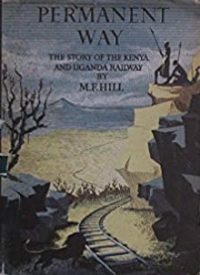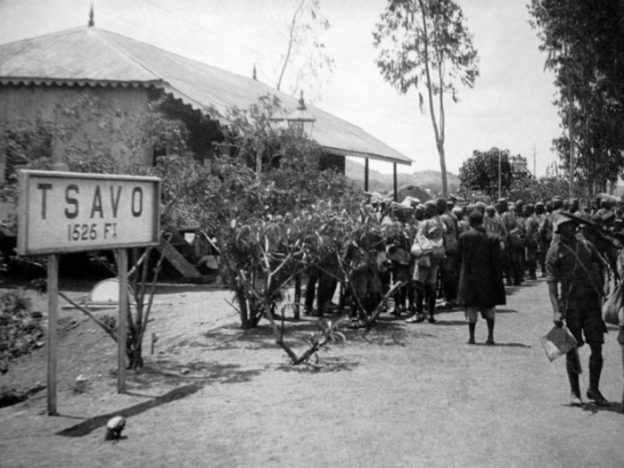 I recently picked up a copy of each of the two volumes of ‘Permanent Way‘ written by M.F. Hill and published in 1949. The first volume [1] is a history of ‘The Uganda Railway’ written in the 1940s when the railway company was known as ‘The Kenya and Uganda Railways and Harbours’ and published at the end of that decade under the jurisdiction of the new ‘East African Railways and Harbours’ which was formed to formally include the infrastructure in the modern country of Tanzania.
I recently picked up a copy of each of the two volumes of ‘Permanent Way‘ written by M.F. Hill and published in 1949. The first volume [1] is a history of ‘The Uganda Railway’ written in the 1940s when the railway company was known as ‘The Kenya and Uganda Railways and Harbours’ and published at the end of that decade under the jurisdiction of the new ‘East African Railways and Harbours’ which was formed to formally include the infrastructure in the modern country of Tanzania.
Hill’s first volume provides a detailed history of the Uganda Railway until just after the end of World War II. This article covers the period of WW1.
Hill provides, at least as far as I can tell, what appears to be a very fair compilation of activity throughout the East Africa Protectorate (EAP) and the Uganda Protectorate UP) during the War. [1: p344ff] There was significant unrest in the EAP contributed to by a range of incompetencies exhibited by the EAP Government based in Nairobi, during the first year of the War. He highlights the importance of a meeting of Settlers in September 2015, which pressed on the Government the need for effective organisation and which resulted in the first elected representation for the Settlers onto a War Council.
Hill says that organisation improved markedly from this time on, although there were still significant losses in the community and the forces particularly due to fever. The German resistance throughout the War is noted by Hill as being one of “courage, endurance and astounding ingenuity” before it surrendered eventually on 25th November 1918. [1: p354]
Hill’s summary of the EAP campaign says: “The most ardent advocate of the East African campaign cannot maintain that it contributed to the ultimate to the ultimate defeat of Germany. The most caustic critic cannot deny that the story of the campaign is an epic of human endurance in the face of terrible trials. Fever, disease and starvation, through the breakdown of a suicidal system of supply, were von Lettow’s [2] allies, and they caused far more casualties than his soldiers.” [1: p354]
Hill points to the War Office record which states that, “during the campaign, 976 officers and 17,650 other ranks were killed, died or missing. Those figures covered the East African, South African, West African, British and Indian troops engaged in the campaign. In addition, 44,572 African porters were killed or died of disease. The maximum strength employed at any time was 24,156 combatants and 187,369 non-combatants. Altogether 112,000 fighting troops and 261,000 non-combatants took part in the campaign. Of the vast army of African porters, on which the transport and supply of the troops in the field mainly depended, nearly 60,000 were recruited in Uganda and the great majority of the remainder came from the Native tribes of the East Africa Protectorate. They were called upon to pay a terrible price in human life and misery because the First German War overspilt from Europe into Africa ” [1: p355]
H.M. armoured train, ‘Simba’ was built in the workshops at Nairobi to counteract the German mounted patrols that carried out nuisance raids on the railway during the War. [3][4] It was destroyed by a mine.
1914-1915 – £180,600 [1: p355]
1915-1916 – £287,300 [1: p360]
1916-1917 – £351,815 [1: p364]
1917-1918 – £208,986 [1: p368]
1918-1919 – £152,255 [1: p370]
During 1915, Parliament approved a loan of £1.868 million for further expenditure at Kilindini Harbour, for railway improvements and for roads and bridges. Only a fraction of the loan was spent until the end of the War. Survey work onthe line from Nakuru across the Uasinn Gishu Plateau did continue. Oil storage at Kilindini and at Kisumu was increased along with work to piers at several ports and Harbours associated with trade on Lake Victoria. One new ship, the ‘Rusunga’, was launched on the lake. [1: p355f]
Hill highlights locomotive developments in 1915: 3 new tank engines were put into service; seven ‘G’ class engines were erected but not out into service until 1817 for lack of flangeless tyres for the leading powered axle/wheel set.
Twenty-nine of the ‘F’ class locos were still working. By the start of the War, the annual engine mileage was 1,862,453 of which the ‘F’ class locos were doing about 50%. The Mallets (18 No.) were doing good work, hauling satisfactory loads, but we’re proving very expensive to maintain. [1: p356]
The Magadi Line opened on 14th January 1915, the Thika Line was still passenger only and already paying its way. The Busoga Railway was crippled by the major drop in export and import traffic. It had also been realised that the costs associated with making Lake Kioga navigable would be exorbitant.
Towards the end of 1915 it was decided to build a new branch line from Voi to Maktau to solve supply problems for the proposed offensive into German East Africa. In due course this line would be extended to Kahe and so would link The Uganda Railway with the line from Tanga to the foothills of Kilimanjaro. [1: p358]
At around this time the military took control of The Uganda Railway. [1: p358f]
By June 1915,1,166 vehicles were being dispatched monthly from Kilindini. In January 1916 this had increased to 2,994 vehicles. Before the end of March 1916, 25 engines and 200 ten ton covered wagons had been imported from India, mainly for the Voi-Maktau line, but also to receive pressure on the main line. Further wagons were purchased from the contractors for the Magadi Line. [1: p359]
A working profit of £287,000 was achieved in the 1915/1916 financial year but there was no significant allowance made for necessary maintenance and a renewals fund had still not been created. The survey of the line across the Uasin-Gishu Plateau was completed and the first mention appeared in an Annual Report of the General Manager of this route becoming the start of a trunk line through Uganda to the Congo. [1: p361]
In November 1915, the Port at Kilindini was taken over by the Royal Navy and closed to civilian traffic. The inadequate Old Port at Mombasa had to be used for all exports.
The March 1817 report if the General Manager drew attention to the wretched state of engines and rolling stock.
Little had changed by March 1919. The General Manager’s report was a repetition of the difficulties of previous years:
“Little had been done to remedy a chronic decay, the difficulties had, inevitably, become more critical. Several engines had been taken out of service either for lack of spares or as not worth repairing. In February 1919, fifteen new ‘G’ class engines were ordered, but they were not expected to arrive before the end of the year. Meanwhile, of the railway’s ninety-two engines, only seventy-seven were in working order and many of those were in bad shape. Most of the railway’s original rolling-stock particularly the second- and third-class carriages, was virtually beyond repair except at great and uneconomic cost. The majority of the machines in the workshops were worn out and incapable of turning out accurate work.” [1: p371]
All the subsidiary lines were also showing a loss and it was recognised that the two lines in Uganda (Busoga and Port Bell) were too small to be operated effectively as separate systems. [1: p372]
“For years the Treasury of the EAP had pillaged the railway in order to balance its budget. Now the Treasury had extended the field of pillage to Uganda. By this time the state of the railway was so derelict and critical that some radical reorganisation could not long be avoided. The surcharge, and the protests of Uganda, proved to be the last straws. Undoubtedly they impelled the series of events and the design of policy which eventually placed the railway on a sounder constitutional basis and a very much sounder financial basis. Unfortunately, this ill-advised surcharge, following upon the long struggle to secure to Uganda a fair allocation of the customs revenue derived from its imports via Kilindini, left a legacy of suspicion and resentment which exercised an unhappy influence on relations between the two territories for many years.” [1: p373]
References
- M.F. Hill; Permanent Way – The Story of the Kenya and Uganda Railway – Volume 1; Hazel, Watson & Viney Ltd, Aylesbury & London, 1949.
- Lieut.-Colonel (later General) von Lettow-Vorbeck was the German commander-in-chief in East Africa and remained so throughout the conflict until the end of November 2018 when surrender became inevitable.
- http://www.kaiserscross.com/188001/293122.html, accessed on 28th December 2020.
- Lieutenant Colonel Charles Hordern; Military Operations East Africa August 1914 – September 1916; Battery Press, Nashville, Tennesse, 1990.
- The featured Image at the start of this article comes from http://ww1blog.osborneink.com/?p=10064, accessed on 28th December 2020



I have a copy of the 1961 (second) edition of MF Hill’s first volume on the Kenya and Uganda Railway. He refers to a second volume ‘Permanent Way, The Story of the Tanganyika Railways’.
Is that the second volume to which you refer, please?
My copy was acquired by a friend in the Diplomatic Service from the British Information Services library (in Nairobi I think, but just possibly Kampala). It has official ‘cancellation’ stamps on it.
Yes Volume 2 has the same title and covers the railways in Tanganyika.
Pingback: The Kenya and Uganda Railways and Harbours – The Great Depression and Years of Argument | Roger Farnworth
Pingback: The Kenya and Uganda Railways and Harbours – The Second World War ….. and after. …. | Roger Farnworth